IT Band Pain: How To Fix It After Total Knee Replacement – (updated 01.23.2024)
Having a total knee replacement can be quite the journey, trust me, I know firsthand!
It definitely comes with its fair share of aches and pains.
But if you do the recommended exercises and follow your doctor’s recommendations, your knee should gradually improve over time.
That being said, I did find that there is a common issue that many people, including myself, still experience after a knee replacement – iliotibial (IT) band pain.
Think of the IT band as a resilient band of fibers that run from your hip to the outside of your knee and beyond.
Unfortunately, this band doesn’t always respond well to drastic changes, like a knee replacement.
IT band pain can be a sharp stabbing pain whenever you stand up or walk just a little too far or a persistent tightness that just won’t go away.
If you are someone who is experiencing this pain after a knee replacement, you don’t have to suffer in silence.
There are plenty of things you can do to manage IT band pain.
In this article, you will find the causes of IT band pain, why it can occur after surgery, and some possible ways to decrease your discomfort.
I’ll also share my personal journey with IT band issues following my own recent knee replacement.
So, let’s conquer this challenge and find ways to make your recovery as smooth as possible!
This post contains affiliate links. As an Amazon Associate, I earn from qualifying purchases. This means I may earn a commission, at no extra cost to you, should you choose to make a purchase using my link.
Understanding IT Band Pain After Knee Replacement
The iliotibial (IT) band is a sturdy, fibrous band that runs alongside the outer part of your thigh.
It runs from the outside of your hips to the outside of your thigh and knee down to the top of your shinbone.
It’s like a trusty strap that stabilizes the knee during activities like running, hiking, and walking—basically any activity when you are on the move.
Role of the IT Band in Knee Replacement
The iliotibial (IT) band is a key player during knee replacement surgery.
Its job is to stabilize your knee joint and offer support to those newly installed artificial parts.
But that’s not all!
The IT band also plays a huge role making sure that you have proper alignment and good function of your knee after surgery.
That’s why giving the IT band the care and attention it deserves during knee replacement recovery is so important.
Symptoms of Iliotibial Band Syndrome
When I experienced IT Band Syndrome after my total knee replacement, I had several specific complaints.
Here’s some symptoms that you may experience if you have IT band syndrome:
Pain: This is probably the most common symptom of IT band syndrome. I often felt a sharp pain or burning sensation along the outside of the knee. This sometimes radiated up my outer thigh or down towards my shin.
Swelling: There was some swelling and tenderness to the touch along the IT band.
Stiffness: Another common complaint is knee stiffness, especially after long periods of sitting or lying down. I really noticed it in the mornings when I would get up.
Popping Sensation: Sometimes, with movement, I noticed a popping or snapping feeling at the knee.
Flexibility Issues: A tight IT band can cause issues with flexibility; I really noticed that I had less flexion and extension of my knee.
These symptoms can change in intensity.
Why Does IT Band Hurt After Knee Replacement
The primary causes of IT band pain after surgery are:
- Inflammation: Your body’s natural response to surgery is to heal the damaged tissues, which can cause inflammation. This can cause irritation of the iliotibial band.
- Scar Tissue Formation: As your knee heals, scar tissue can develop, which can lead to tightness around the knee joint and piss off the IT band.
- Changes in Gait: Because of the post-op pain and new joint, you may start to walk differently. These changes can stress the IT band.
- Muscle Weakness: Muscles supporting the knee, especially the quads (front of upper leg) and hamstrings (back of upper leg), can weaken from the surgery. If these muscles aren’t strong enough, more strain is placed on the IT band.
To help control these causes:
- Do the prescribed physical therapy exercises.
- Apply an ice pack to the area to help reduce the inflammation. – this was my best friend!
- Gradually increase your activity level to build muscle strength.
My IT Band Experience After TKA
When it comes to my experience with IT band pain, I noticed it kicking in around 6-8 weeks after my total knee replacement.
I realized that I was pushing myself too hard (and probably too fast) with my strengthening exercises. I started adding more and more squats and high lunges with light weights.
Plus, I wasn’t stretching as much as I should have been.
To be honest, I didn’t feel that warming up or cooling down before and after my workouts was a big deal.
Boy, was I mistaken!
On top of that, I still hadn’t returned to practicing yoga since I was still limited in some yoga poses because of my ongoing recovery and limited range of motion.
However, I found some stretches that I could still do, and they turned out to be incredibly helpful!
I also discovered foam rolling, it became both my friend and my nemesis.
Sure, it hurt while I was using the foam roller, but it worked wonders for decreasing my pain afterwards!
I also decided to give massage therapy a shot.
My massage therapist wouldn’t start working on my leg until I hit the 8-week post-surgery mark. But once she did, it was truly a game changer.
Finally, a breakthrough!
I also invested in a massage gun, which was also super helpful.
To this day, I still use the massage gun whenever I have a flare-up or when I need to loosen up some tight muscles.
5 Exercises to Fix IT Band Syndrome After Knee Replacement
Here are a few of the exercises that I was able to do at 6-8 weeks post-op to help relieve the IT band pain.
1. Cross-Leg Stretch
- Start in a standing position behind a chair or near a wall for support.
- Point your feet out in front of you.
- Cross the surgical leg (for me that is the left knee) behind the other leg (right knee)
- Bend over at the waist.
- Feel the stretch?
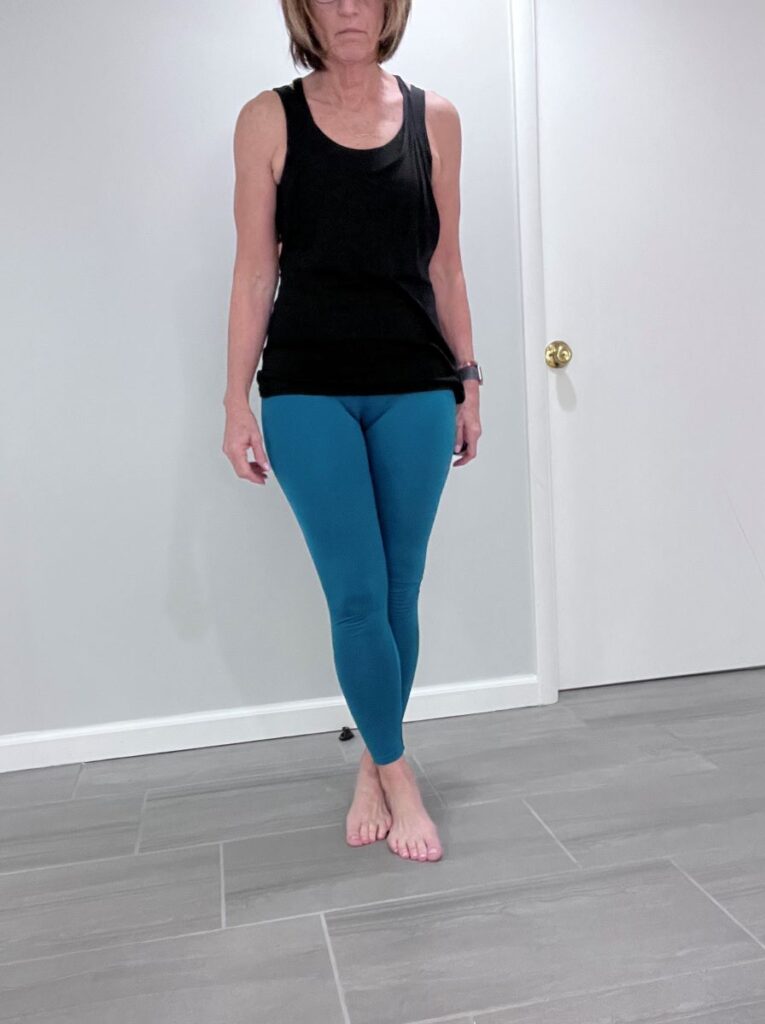
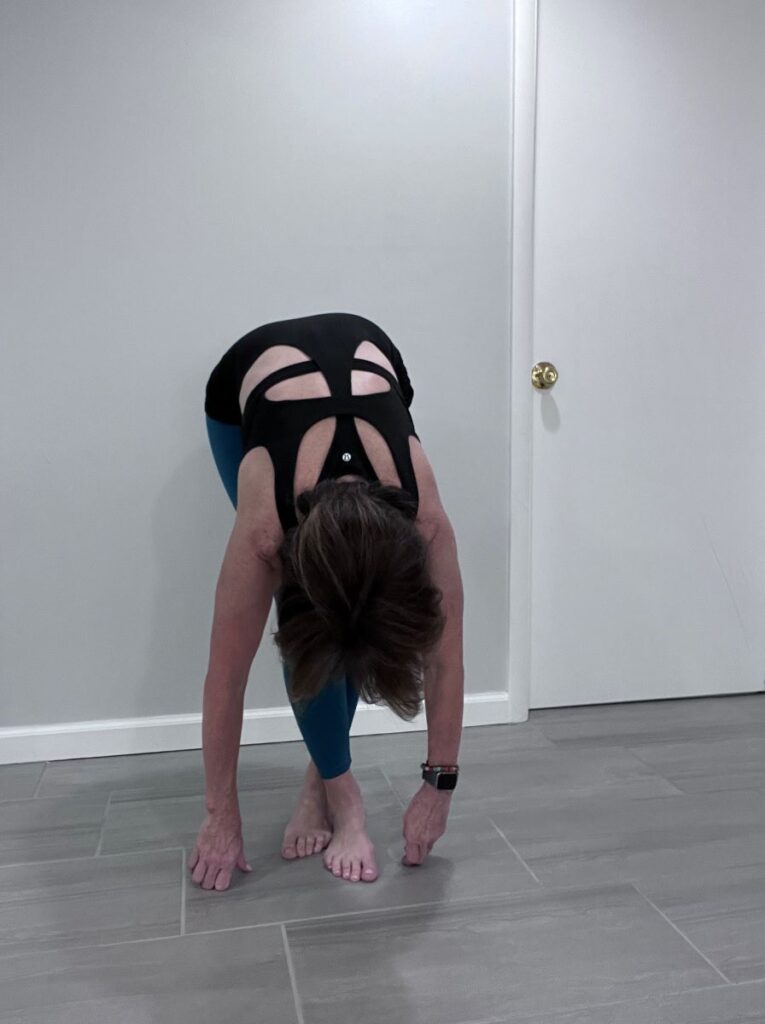
2. Lying Cross Over Leg Stretch
- Lie on your back.
- Carefully bend your surgical leg to 90 degrees or as close as you can.
- Cross the surgical leg (left leg) over the non-surgical leg (right leg).
- Bend the bottom (non-surgical) leg and pull it in towards your chest. Take your time and only go as far as you can tolerate.
- Hold the stretch for 30 seconds.
- Release and repeat
- If you are able to raise the non-surgical leg straight up this can give you a deeper stretch.
- If this exercise is at all painful at the knee STOP the exercise.
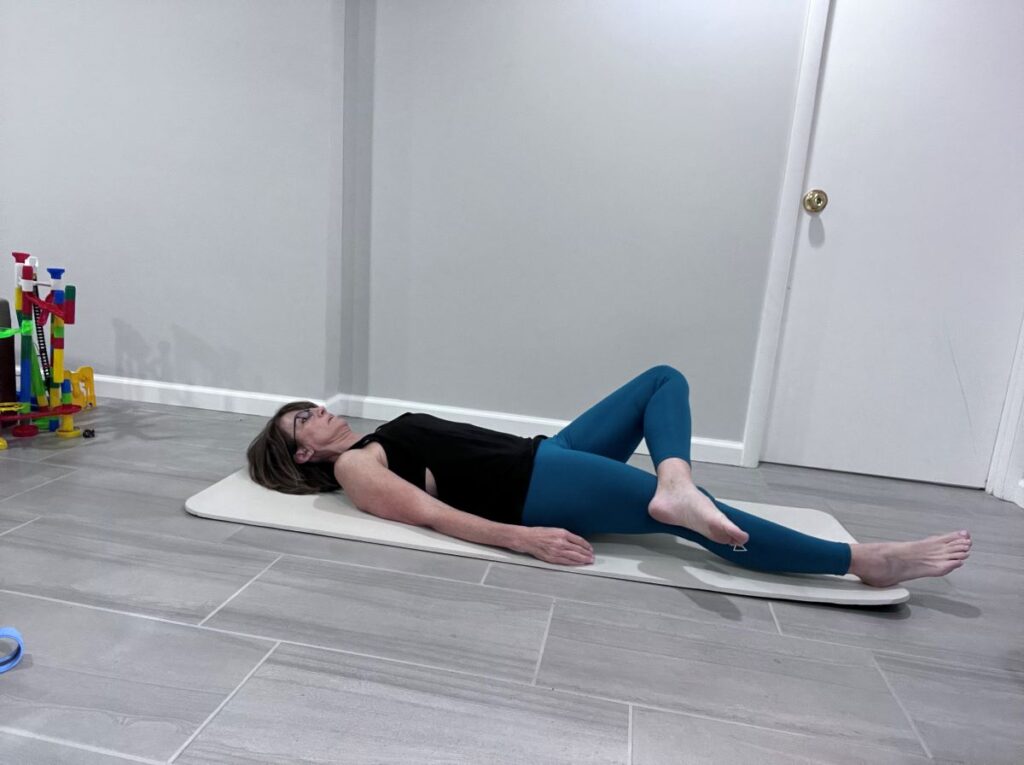
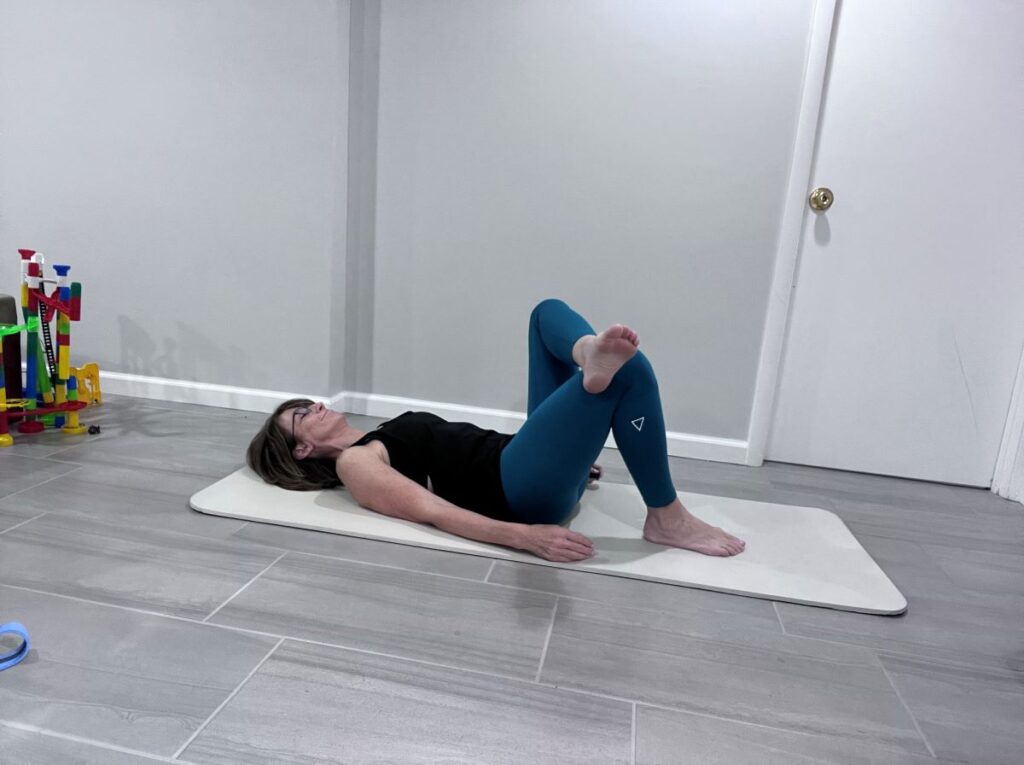
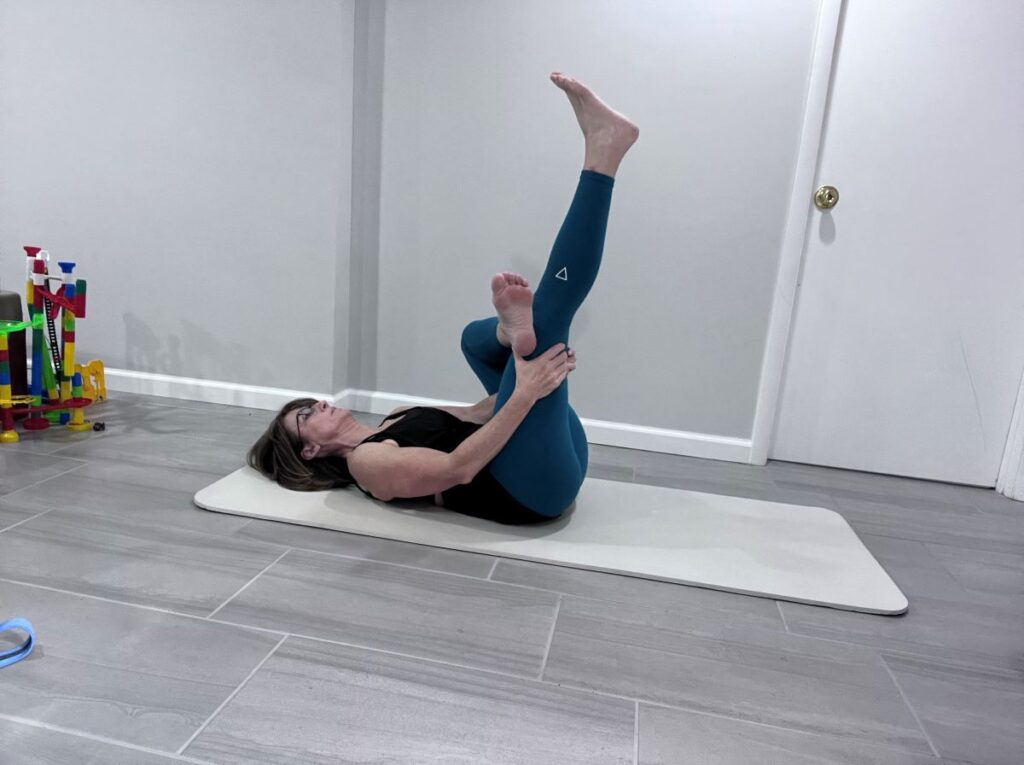
3. Lying Down Stretch with Band
- Lie down on your back
- Take a yoga band, resistance band, belt, or towel around the foot of your surgical leg.
- Keep both hips on the ground.
- Pull leg over to the opposite side of the body.
- Be sure to keep hips flat on the ground.
- Hold for a 10-15 seconds and repeat.
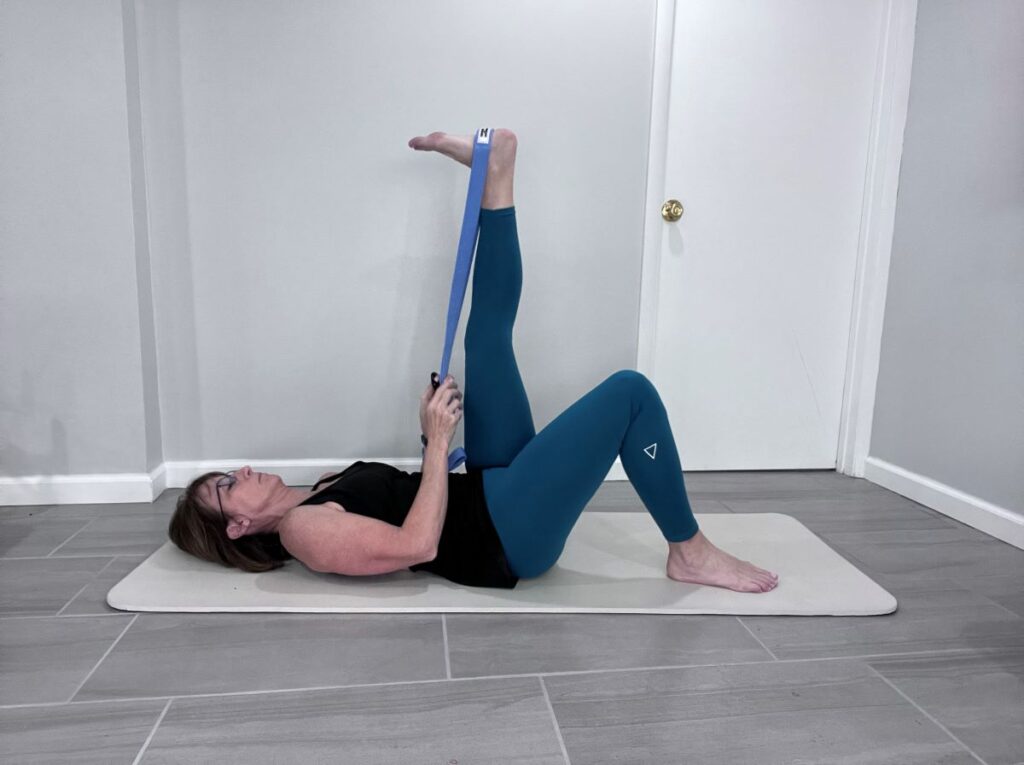
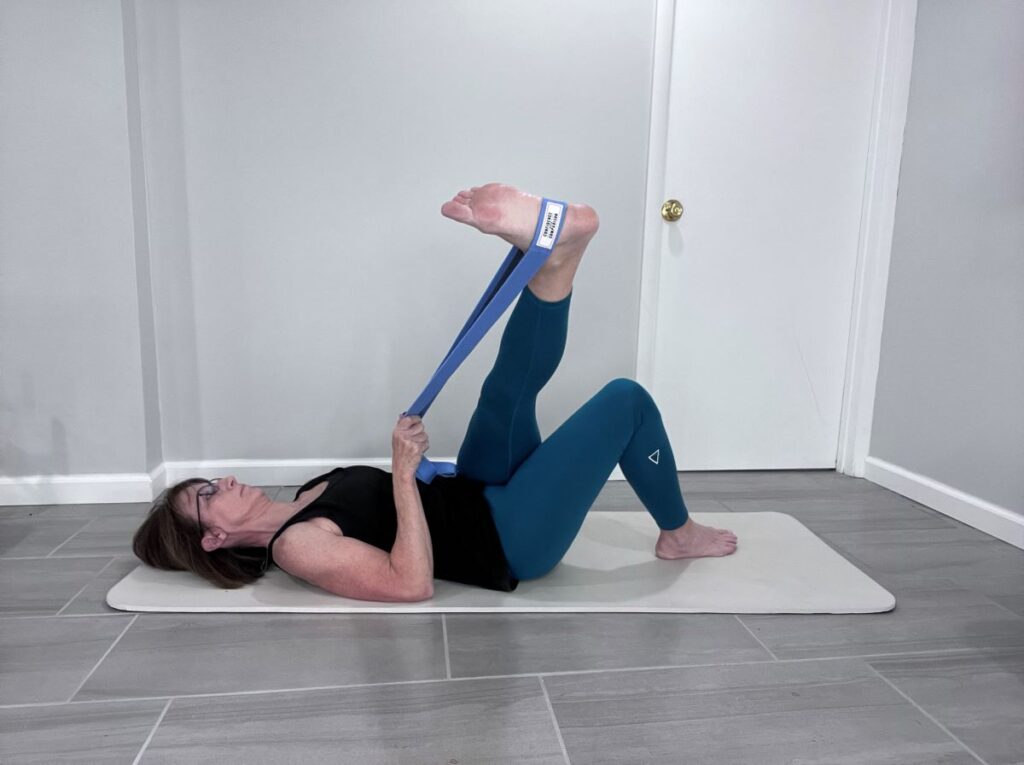
4. Foam Roller Stretch
- Grab your foam roller.
- Roll to your surgical side and place the foam roller under your hip.
- Roll back and forth.
- When you find a tender spot stay on the spot for a few seconds (yes it will hurt)
- Then release and continue to roll down the leg to the next tender spot.
- Do not roll over the knee itself. Just hip to above the knee.
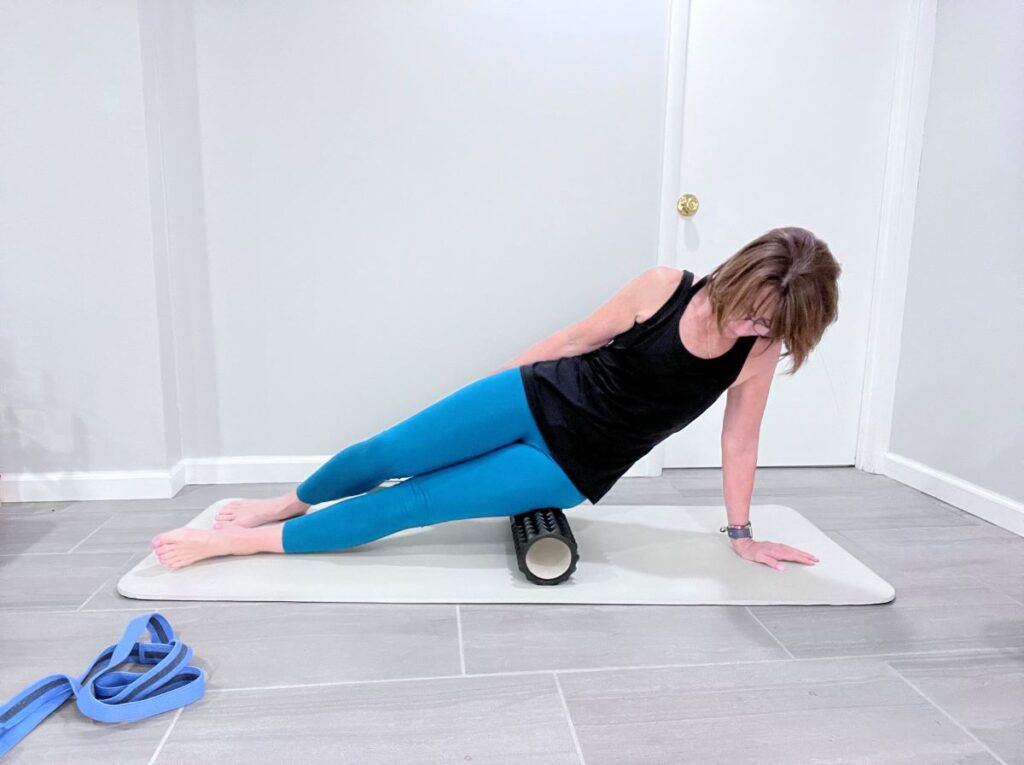
5. Massage Gun
- For this one, you can sit, stand, or lie down
- Turn the massage gun on – start on a low setting at the hip.
- Move down the leg towards the knee and stop on the tender spots.
- Hold over the tender spots for 10-20 seconds and then move on.
- Increase the intensity as tolerated.
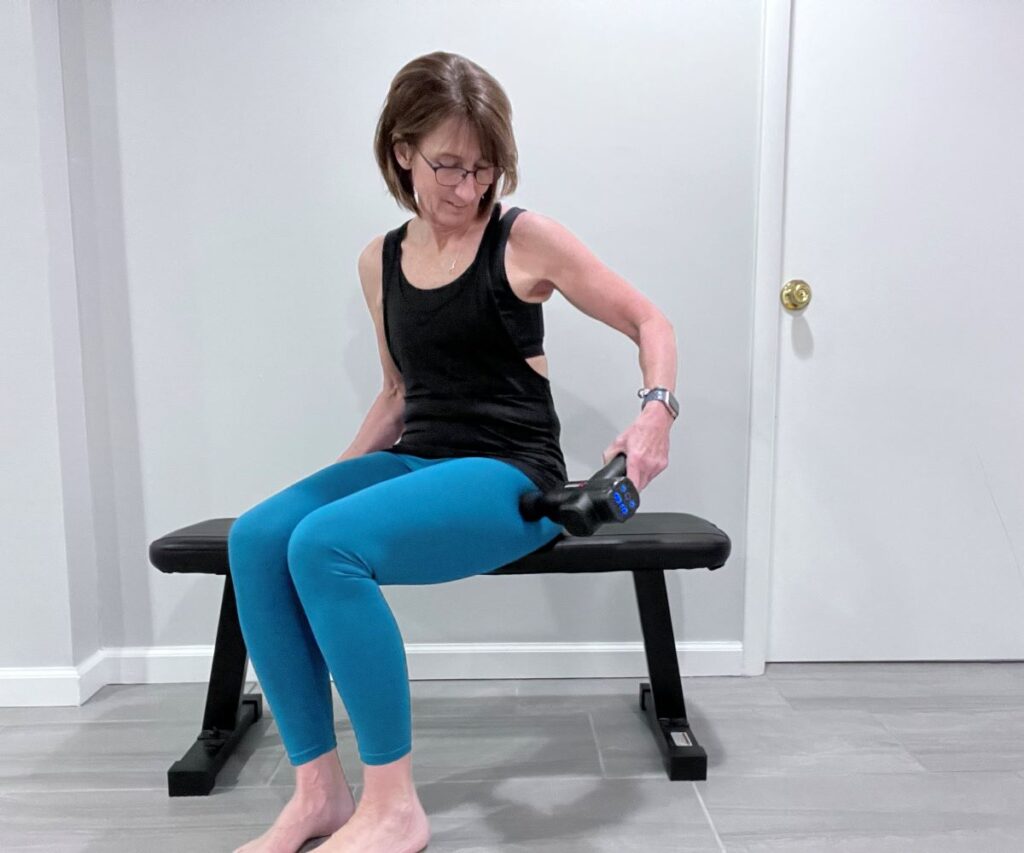
Non-surgical Treatment Options
To manage IT band pain after total knee replacement, it’s important to try different approaches that may help.
Physical Therapy
Talk to Your physical therapist or an athletic trainer:
They may give you some specific exercises to try or they may suggest that you restart or continue your rehabilitation program.
Medications
Your healthcare providers may recommend anti-inflammatory medications to help decrease your inflammation and pain.
Injection Therapy
If the conservative treatment of exercise and medication don’t seem to help, your doctor may recommend steroid injections to help decrease your inflammation.
I did not need an injection, but I do know some people that did need this and were pleased with the results.
Surgical Intervention
In more severe cases – your knee doctor might recommend surgical intervention.
One surgical option is selective iliotibial band release, which involves cutting a portion of the IT band to relieve tension and reduce pain.
Another option is revision total knee replacement, which involves replacing the original knee replacement with a new implant.
This is only recommended when the pain is still unbearable after trying all conservative treatments.
Prevention of IT Band Pain After Total Knee Replacement
There are several preventive measures that you can take to decrease your risk of developing IT band pain after surgery.
Here are a few to consider:
1. Maintain a healthy body weight
Keeping a balanced weight through a combination of diet and regular exercise is very important.
Excess weight adds stress to the knee joint, which can lead to IT band pain.
2. Regular stretching exercises
Including regular stretching exercises in your routine can improve flexibility and reduce the risk of IT band pain.
The American Association of Hip and Knee Surgeons (AAHKS) even has a home exercise program for treating ITBS.
3. Follow the post-operative rehab program
It’s important to follow the rehab program prescribed by your knee surgeon. Physical therapy plays a very important role in improving strength and flexibility in the knee joint.
4. Avoid overusing the knee joint during recovery
It’s important to give your knee joint enough rest during the recovery period.
Overusing it can increase stress and the likelihood of IT band pain.
5. Choose a qualified surgeon
Find a skilled and experienced surgeon for your knee replacement surgery.
A good surgeon can minimize the risk of post-surgery complications.
Conclusion
Experiencing IT band pain after a total knee replacement is a common concern, but rest assured, there are effective ways to treat and manage it.
Combining at-home remedies with proper treatment from your surgeon and therapist can make a huge difference.
One important thing to remember is that healing takes time, so be patient with yourself throughout the process.
Don’t hesitate to reach out to your doctor if the pain persists or worsens despite trying different treatments.
It’s important to understand that each person’s healing journey after total knee replacement surgery is unique.
So, remember to explore and find the approach that works best for you!
You will be back to your normal activity in no time!

Thanks, very helpful and encouraging. 6 weeks out and my right knee is a problem child. Working through it.
I’m glad that you found it helpful!
The first 2-3 months can be frustrating, but then it gets better. Stay in touch and let me know how you’re doing.
Great article! I appreciate the clear and insightful perspective you’ve shared. It’s fascinating to see how this topic is developing. For those interested in diving deeper, I found an excellent resource that expands on these ideas: check it out here. Looking forward to hearing others’ thoughts and continuing the discussion!
I am very thankful that I found this article, I have some many questions and no body explain. I only have to say thank you 🙏🏼
Email is [email protected]
Awesome. I’m 6 weeks post op and experiencing exactly what you describe. I was crying at the drop of a hat for nothing. Now I know what it is and will do the above. Thank you so much
I’m sorry to hear that you were having problems but so glad that you found this helpful for your issues. Let me know how you’re doing!
Having some pain outer thigh will try massage gun
I am just past 7 weeks of total knee replacement. My physical therapist has done one day of extensive massage therapy. He just started. Also different kinds of stretches. How long does this issue take after getting it worked on approximately?
It will take a couple of weeks to really notice a difference. 4-6 weeks of consistent stretching to feel close to normal again. Or at least that was my experience.
This was incredibly useful information. I am doing most things that you recommend here, but it’s good to know I’m not alone! Frustrating for sure when your knee joint itself feels great (that was the problem, right?) but your leg not so much. I don’t know how many times my providers have told me “Give it time, it’s only been (fill-in-the-blank) weeks.” I’m 12 weeks post op right now. Ugh. I have also found that wearing a knee support or compression hose also helps tremendously.
It can be very frustrating for sure! I am so glad that you found a way to help with the pain. I have also found (after another bout of IT band syndrome) that a TENS unit can be helpful as well.
Thank you so much for sharing a new tip that can be helpful for everyone.
Eight months out and still painful. Religiously active PT 2-3 times weekly, and still painful. Stretching and biking at home, same lack of results. Hopefully your article is a game changer. Thanks for the information!
IT band pain can be extremely painful. Have they tried any dry needling at PT? That seemed to help me when my IT band flared back up before my hip replacement surgery recently.
I truly feel for all of you who left responses. I’m experiencing the same issues but I have a lot of fatigue and it’s very upsetting. I’m trying to be patient. It’s been 6 weeks since my surgery and I do have PT sessions. Thank you all for feeling my pain. I’ll try harder.
Well I’m 6 months out..,still doing my PT exercises and can barely tolerate the weight beating pain. Tired of hearing “give it time!” Pain down front of leg to second toe which has gone numb. Yes I feel I’m going to have to insist on an MRI. THIS hasn’t been right from the beginning. My leg went totally black with bruising. Thx for suggestions.
Have you considered a second opinion? This could be very helpful for you after 6 months of the pain. They may be able to help you figure out why you are not healing.